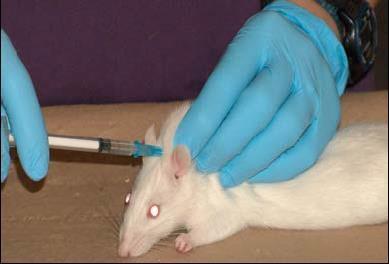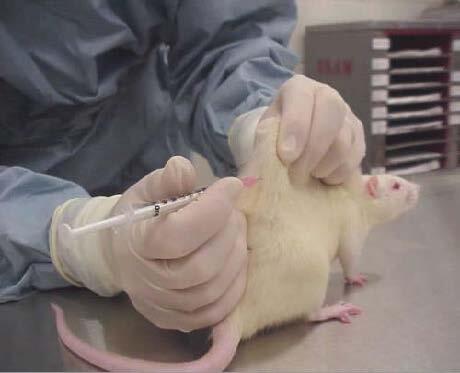University Animal Care Committee Standard Operating Procedure
Document No: 10.20
Subject: Manual Restraint of Rats
Date Issued: May 21, 2015
Revision: 2
Location: Queen’s University
Responsibility: Principal Investigators (PI), Research Staff, Veterinary Staff
Purpose: The purpose of this Standard Operating Procedure (SOP) is to describe commonly- used manual restraint techniques for rats.
Abbreviations:
subcutaneous SC, intravenous IV, intraperitoneal IP, intramuscular IM, per os PO
1. Introduction and Definitions:
Correct manual restraint is used in order to avoid and/or limit pain and distress to the rat. It is a valuable tool for competently performing several standard procedures such as a general health assessment, blood collection, tissue collection and ear-punching. Additionally, correct restraint aids in administering substances via the most commonly used routes. Limiting the use of anesthesia through proper restraint is of benefit to the animal and researcher.
2. Materials:
- Personal Protective Equipment (gloves, lab coat, mask, cap)
- Cage and wire lid
- Restrainers
- Small surgical drape or towel
3. Procedures
General:
The handler should approach the rat quietly and confidently, allowing it to sense and smell their presence. Once the cage lid is opened, grasp the rat at the base of the tail. Holding the tail distal to the base can result in a degloving injury. Use the other hand to slip under the animal’s abdomen and lift the rat out of the cage and onto the crook of your bent forearm. This will provide support, and the rat can bury its head in the bend of your arm which will help it to relax. Always maintain a hold on the tail. The rat may be carried short distances in the fashion. Rats are very sensory animals and enjoy stroking at the nape of their neck and even tickling of their abdomen. You can effectively calm a nervous animal through gentle petting. Do not attempt to grasp rats at the nape of the neck, they object strongly to being restrained by the scruff. Rats can inflict painful bites with their incisors.


V-Hold or Suspender Hold:
This hold is commonly used when a firmer restraint is required, such as for oral gavage or two-person IP injections.
- Grasp the whole torso, with the index and middle fingers along the sides of the head and the thumb and remaining fingers under the axilla.
- Alternatively, circle your thumb and index fingers under the jaw to control the head while the rest of your finger support the chest behind the forelegs. Use your other hand to support the lower body and hold the tail. Both methods restrict head movement while allowing access to the facial area.
- The animal’s arms can be gently crossed and held closed for additional security.
- Applying too much pressure to the head or chest can result in struggling and injury to the animal.



Scruff Hold:
This hold is commonly used for subcutaneous injections. At Queen’s University we recommend using the Camilla Method for administering injections (if practical). This technique uses a cloth as a simple restraining device and provides the animal with a place to hide which will help it to relax.
- Lift the rat from its home cage to a clean, flat surface.
- Cover the rat’s head and upper body with a cloth. Prevent the animal from advancing forward using the edge of your hand. Use that same hand to form a skin tent. Give the injection with your free hand, bracing its backside if necessary.
- Alternatively, with animals that have been handled frequently and are accustomed to
injections, the user may be able to bypass the towel method and simply form a skin tent with
one hand as the other administers the injection into the scruff or flank of the animal.


Torso or Sausage Wrap:
This hold is commonly used for IP injections. It can also be used to restrain the animal for SC or IV injections, and blood sampling.
- Lift the rat from its home cage to a clean, flat surface where a towel or small drape is laid flat.
- Place the cranial 2/3 of the animal on the towel in the lower third of the towel.
- Firmly roll the lower third portion of the towel around the rat.
- Fold the excess towel back over the animal’s body to create a pocket.
- Wrap the remaining 2/3 of the towel securely around the rat to immobilize it.
- Brace the “sausage” between your forearm and hip with the abdomen facing upwards.
- Hold the tail and if possible, a leg. This will allow easy access to the IP injection site.





Novel IP restraint technique:
This hold was developed for animals that are accustomed to handling. It alleviates stress to the animal, and allows for clear visualization of the needle hub

| Date | New Version |
|---|---|
| 05/21/2015 | SOP Created |
| 02/28/2019 | Revised |
| 02/28/2022 | Revised |











